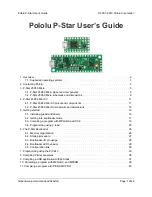
The board’s power selection circuit uses the
from Texas Instruments to choose whether its 5 V supply is sourced from USB or an
external supply via the regulator, allowing both sources to be connected at the same time and enabling
the P-Star to safely and seamlessly transition between them. The TPS2113A is configured to select
external power unless the regulator output falls below about 4.5 V. If this happens, it will select the
higher of the two sources, which will typically be the USB 5 V bus voltage if the P-Star is connected
to USB. The currently selected source is indicated by the
STAT
pin in the middle of the board; this pin
is an open-drain output that is low if the external power source is selected and high-impedance if the
USB supply is selected. The current limit of the TPS2113A is set to about 1.9 A. For more information
about the power multiplexer, see the
[https://www.pololu.com/file/0J771/tps2113a.pdf]
(1MB pdf).
In some situations, it might be undesirable for the P-Star 45K50 Mini to draw power from an external
source when it is connected to USB. If this is the case, the regulator can be disabled by driving the
regulator shutdown pin,
SHDN
, high; this shuts down the regulator and causes the power mux to fall
back to USB power. For example, this could allow a battery-powered device to turn off the regulator
and avoid draining its battery while it is connected to a computer.
USB power input:
The P-Star can be powered from the USB 5 V bus voltage (VBUS) if it is connected
to a USB cable. It will draw power from USB only if its external voltage source is disconnected.
Reverse-protected power inputs:
The BAT+ and BAT− are power inputs with reverse-voltage
protection. These are the recommended pins to use when connecting an external power supply
because they allow the P-Star’s reverse-voltage protection circuit to help prevent it from being
damaged by accidentally reversed power connections.
VIN power output (or alternative input):
When power is supplied through the BAT pins, the VIN
pin can be used as an output to supply reverse-protected power to other devices. Alternatively, the
external supply can be connected directly between VIN and GND, bypassing the reverse-voltage
protection.
5V power output:
This pin provides access to the board’s 5 V supply, which comes from either the
USB 5 V bus voltage or the on-board switching regulator, depending on which power sources are
connected and enabled.
3V3 power output:
This pin gives access to the output of the on-board 3.3 V linear regulator, which
can provide a few hundred milliamps of current.
VDD:
The VDD pin powers the microcontroller and is connected directly to the 5V power output.
Pololu P-Star User’s Guide
© 2001–2019 Pololu Corporation
4. P-Star 45K50 Mini SV
Page 13 of 46




























